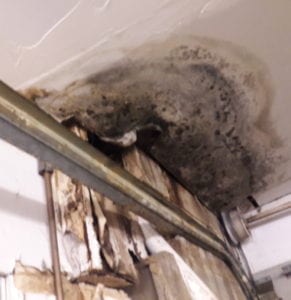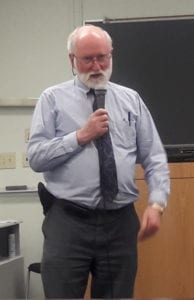Superstorm Sandy task force looks to remedy, repair

Though it’s been more than five years since Hurricane Sandy ravaged Long Island, many people, including Huntington Station resident Sheryl Cohn, are still feeling its effects like the storm only happened yesterday.

In an interview after the April 11 public hearing at Stony Brook University conducted by the Suffolk County Legislature’s Superstorm Sandy Review Task Force, Cohn said her roof was ruined in the wake of the storm, and her house is falling apart around her. The ceiling in her guest bedroom fell and crashed onto the bed, and black mold has sprouted in many rooms around her house. The masonry on the outside of her home — finished only a few months before Sandy hit — fell to pieces on her driveway. She lives in fear that a piece of ceiling will fall on her head while she sits or sleeps.
“My grandson, he turned five in March, he has never been here,” Cohn said. “I would never be able to forgive myself if, God forbid, he contracted something or a piece of sheetrock fell on his head. It makes me feel horrible. He lives a half an hour away, and he’s never been to Nana’s house.”
She first looked into a contractor to fix her roof, but the firm she hired disappeared with all of the money she had already given them. She said the NY Rising Community Reconstruction Program, the state program that was created to provide aid to people whose homes were damaged during the storm, has constantly told her wrong information and switched caseworkers with her multiple times. Now she says they have stopped returning her calls and emails. Five and a half years later she still has no progress on acquiring any financial aid.
As some of the effects of Sandy linger on, Legislator DuWayne Gregory (D-Amityville), the Legislature’s presiding officer, helped to create the Superstorm Sandy Review Task Force, a 27-member committee of government representatives, scientists, engineers and other experts to make recommendations on how to deal with the lasting effects of Sandy as well as prepare Suffolk County for the next big storm.
“My grandson, he turned five in March, he has never been here. I would never be able to forgive myself if, God forbid, he contracted something or a piece of sheetrock fell on his head.”
— Sheryl Cohn
The task force is divided into four working groups including emergency response, resiliency, recovery and infrastructure.
“As we go and narrow down the issues they want to focus on, we want to look at what went wrong, what are the recommendations, what are the solutions,” said Joshua Slaughter, Gregory’s aide. “We don’t want to reinvent the wheel, but we want to come out with things to make it better.”
The task force plans to have more meetings and come up with a document by December that will provide recommendations for the county.
While much of the focus of the task force is focused on the South Shore, where the damage was much more severe, problems from the North Shore not only deal with damaged property but the severe risk of beach erosion and property loss for people living close to the shore.
Professor of oceanography at Stony Brook University and task force member Malcolm Bowman said there is not enough solid data to say that “storm of the century” Sandy won’t be repeated in the near future and that rising sea levels will make each new storm do more damage.
“Five, 10, 25 years from now it will take less of a storm to do the same amount of damage,” Bowman said. “That is the challenge that we have to think about and be prepared for.”

There are both natural solutions and engineered solutions up in the air for trying to fix Long Island’s receding beachline, according to Bowman. Natural solutions include planting seagrass and reestablishing oyster beds to hold the land in place, while engineering solutions include barriers and other human-made structures. Bowman said that both will come into play when preparing for upcoming storms.
Regarding aiding those who are still affected by Sandy navigate their recovery, Slaughter said the task force was thinking about recovery advocates, somebody who can be hired by the state to work with people on a consistent basis.
“I know it will be difficult, there are a lot of cases, but if you leave it to that one on one, people will be running forever, and not every consumer can get out as well as others,” Slaughter said.
“The vast, vast majority of our contractors did the best to their ability, but of course the ones we hear about are those who put people in a bad position or were unscrupulous,” chair of the task force Dave Calone said. “Our job as a governmental entity is to make recommendations to limit that as much as possible.”
Another task force meeting took place April 18 at the Southampton Town Hall. Two more meetings are scheduled for April 26 at Patchogue-Medford High School and May 2 at Babylon Town Hall.






